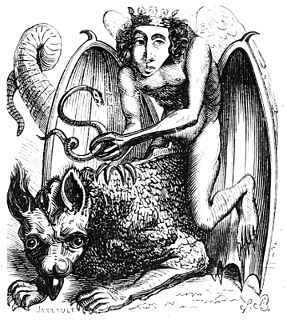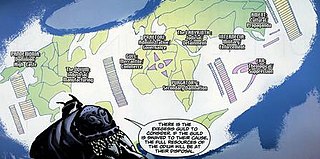
Astaroth, in demonology, is the Great Duke of Hell in the first hierarchy with Beelzebub and Lucifer; he is part of the evil trinity. He is a male figure most likely named after the Mesopotamian goddess Ishtar.

Aamon, in demonology, is a Marquis of Hell who governs forty infernal legions. Aamon is a demon and the Grand Marquis of Hell and the seventh spirit of the Goetia.

Baal is one of the kings of Hell in 17th-century goetic occult writings. The name is drawn from the Canaanite deity Baal mentioned in the Hebrew Bible as the primary god of the Phoenicians.

In demonology Allocer is a demon whose title is Great Duke of Hell, and who has thirty-six legions of demons under his command. He induces people to immorality and teaches arts and all mysteries of the sky.
In demonology, Balam is a great and powerful king of Hell who commands over forty legions of demons. He gives perfect answers on things past, present, and to come, and can also make men invisible and witty.
In demonology, Dantalion is a powerful Great Duke of Hell, with thirty-six legions of demons under his command; he is the 71st of 72 spirits of Solomon.
In demonology, Bathin is a duke of Hell, who has under his command thirty legions of demons. He knows the virtues of precious stones and herbs, and can bring men suddenly from one country to another. He helps one attain astral projection, and takes one wherever one wants to go.
In demonology, Buné is a Great Duke of Hell, mighty and strong, who has thirty legions of demons under his command. He changes the place of the dead and makes them demons that are under his power to gather together upon those sepulchres. Buné makes men eloquent and wise, and gives true answers to their demands and also richness. He speaks with a deep voice.
In demonology, Gusion is a strong Great Duke of Hell, and rules over forty legions of demons. He tells all past, present and future things, shows the meaning of all questions that are asked to him, reconciles friends, and gives honor and dignity.
In demonology, Vepar is a strong Great Duke of Hell, and rules twenty-nine legions of demons. He governs the waters and guides armoured ships laden with ammunition and weapons; he can also make, if requested, the sea rough and stormy, and to appear full of ships. Vepar can make men die in three days by putrefying sores and wounds, causing worms to breed in them, but if requested by the conjurer he can heal them immediately.

In demonology, Vual is a mighty Great Duke of Hell, commanding thirty-seven legions of demons. He gives the love of women, causes friendship between friends and foes, and tells things past, present and to come.
In demonology, Vapula is a powerful Great Duke of Hell that commands thirty-six legions of demons. He teaches philosophy, mechanics, and sciences. Vapula is depicted as a griffin-winged lion.

There have been various attempts throughout history by theologian scholars in the classification of Judaeo-Christian demons for the purpose of understanding the biblical and mythological context of adversarial spirits. Theologians have written dissertations in Christian demonology, classical occultism, classical mythology and Renaissance magic to clarify the connections between these spirits and their influence in various cultures. The study of demonology was historically used to understand morality, behavioral tendencies, and has even been used as symbolism to relay anecdotal tales in folklore.
In some occult and similar writings, an archdemon is a spiritual entity, prominent in the infernal hierarchy as a leader of demons. Essentially, the archdemons are the evil counterparts of the archangels.
In demonology, Murmur is a Great Duke and Earl of Hell, and has thirty legions of demons under his command. He teaches Philosophy, and can oblige the souls of the deceased to appear before the conjurer to answer every desired question. Before his rebellion against God, Murmur held the name "Matthias."

Barlowe's Inferno details artist/author Wayne Barlowe's imaginary journey to a unique and vivid depiction of Hell. A loose running narrative to the book's striking images explains that Barlowe has made an undisclosed deal in order to be taken on a tour of the Pit by Sargatanas, the Revealer of Hell, and one of the Demons Major. The Demons Major are Hell's ruling class, and below them serve the Demons Minor. Human souls make up the lowest rung of Hell's hierarchy and are also its chief resource, being easily twisted and reshaped by their masters into beasts of burden, means of conveyance, war machines, and building materials.
In the Dungeons & Dragons fantasy roleplaying game, "rabble of devilkin" is a term applied to the lesser unique outcast devils dwelling on Avernus, the first layer of the Nine Hells.

Hell is a fictional location, an infernal Underworld utilized in titles published by DC Comics. It is the locational antithesis of the Silver City in Heaven. The DC Comics location known as Hell is based heavily on its depiction in Abrahamic mythology. Aside from a brief appearance in DC Special Series #8 (1978) that was never referred to or even mentioned again, the DC Comics concept of Hell was first mentioned in The Saga of the Swamp Thing #25-27 and was first seen in Swamp Thing Annual #2 (1985), all of which were written by Alan Moore and illustrated by Stephen Bissette and John Totleben.







